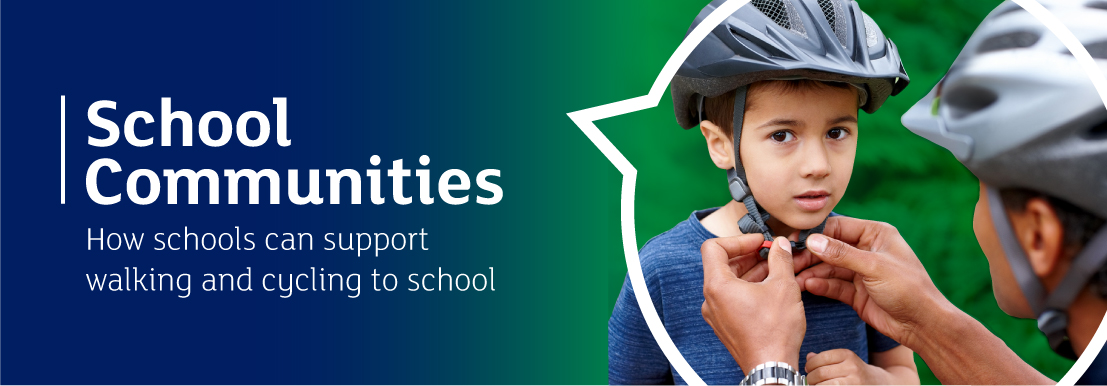
Walking, wheeling and cycling to school information
This section contains key facts and figures, as well as practical tips and recommendations on supporting children around more dangerous traffic locations when they are walking and cycling. This information can be used in the classroom, as well as be shared with parents as part of promotions around walking and cycling to school.
What are the key facts and benefits of walking, cycling and wheeling to school?
Key facts around walking/cycling to school
-
In England and Wales, the number of children being driven to school continues to decrease, while walking to school is increasing. In 2021, 45 per cent of children in England and Wales walked to school and three per cent cycled to school1
-
Transport is the most significant contributor to air pollution in the UK2
-
One in four cars on the road at 9am are on the school run3
-
Over 2,000 schools and nurseries in England and Wales are within 150m of a road with illegal levels of air pollution4.
Benefits of walking/cycling to school
-
80 per cent of people who are obese at age 4 or 5 remain obese for the rest of their lives5
-
Inside the car, you can be exposed to levels of air pollution that are more than three times higher than a cyclist or someone walking in the same street6
-
Families could save £400 per year if their children walked to school instead of being driven to school7
-
In Wales, 90 per cent of children live within a 15-minute walk of a primary school and 75 per cent live within a 15-minute cycle of secondary school8 9
-
Concentration levels of children who cycle or walk to school are eight per cent higher after four hours than for children who are getting a lift by car10.
Tips and recommendations for walking, scootering and cycling to school
This section outlines tips, ideas and recommendations for supporting and encouraging walking and cycling to school. These are tried and tested ways of engaging parents and the wider school community and bringing them with you on the journey to increase the number of children and parents walking and cycling. Please note: we suggest that these recommendations be carried out together rather than as isolated activities in order to be most effective.
Getting pupils onboard with walking and cycling, as a way of engaging parents
The school, council or a keen group of children can make a difference if their school empowers them. Having curriculum activities where children think about the impact of school-run traffic, discussions in class, an assembly and information sent out to parents will help make a change. Parents will often get involved in events and activities if their children are engaged with problems linked to the school run, and ask them to do something or be part of a change to the school journey. Children can be the best promoters and innovators, coming up with ideas to tackle school-run problems that the
school community faces.
Identifying keen teachers and parents who can promote walking and cycling
Children do not often need to be persuaded to walk or cycle; it is the parents. Having keen parents and members of the school community who can advocate for, promote and be seen walking and cycling can help encourage other parents to try walking and cycling to school. This cannot work in isolation though, and some promotional work directed at parents and getting kids to encourage parents is required to succeed.
Promotional events linked to walking and cycling
Holding fun, engaging events that promote walking and cycling can work well in getting parents on board. This could be a simple Dr Bike session where bikes are repaired or a Walk or Cycle to School Day, where prizes/house points are given to those who walk/cycle to school and leave the car at home. Events work better at the beginning of the school year and in summer when the weather is better. Your local council's transport or active travel teams can support an event and should be contacted. An event should be supported by promotional communications targeting parents. An assembly to build excitement in the pupils/students should also take place to ensure they are primed to support an event.
Curriculum activities
While not vilifying parents who have to drive, any curriculum activities should seek to encourage awareness around why walking and cycling to school is preferred. Including cycling and walking within the curriculum can help inform and give children the opportunity to think about walking and cycling and the benefits on the school and wider community, including on the environment, traffic, air quality and health and wellbeing. Communicating with parents about walking and cycling should follow any discussions/sessions with children and will help parents consider how they travel to school. We have created an ‘Ideas for including safe walking and cycling in the curriculum’ factsheet, which provides further information on including safe walking and
cycling in the classroom.
Parking exclusion zones/School Streets
Introducing an exclusion zone around the school can help parents think about their school run. Many schools have created a 5-minute parking exclusion zone, identifying the area immediately around the school and within a five-minute walk as a no-parking zone for parents. This can work well, setting out expectations and tackling potential issues around parking immediately outside the school and complaints from residents living close to the school. Many schools are also participating in a similar scheme called School Streets, a temporary closure of streets around schools that many councils are offering across the UK. If you would like to create a five-minute parking exclusion/walking zone map or enquire about School Streets, please ask your council's Active Travel team for further information. We have also created a Quick Guide to School Streets with further information.
References